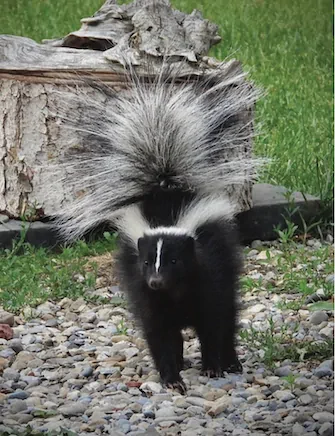
One of my favourite neighbours is not afraid to standout in a crowd; their plume of a tail bobs fluidly behind as they waddle across my path, jet black fur accented with bold white stripes loudly announcing their presence. It is the Striped Skunk. Some people see a skunk and run in the opposite direction. Perhaps the name Mephitis mephitis, which translates to noxious
smell twice, elicits this response. I am undeterred. I have spent countless hours following and watching these beautiful creatures, I even had one raise a litter under my duck coop and have yet to be sprayed. Am I just incredibly lucky or is this kind of coexistence the norm?
The eccentric colouration of the skunk is what is known as an aposematic signal. It warns would be predators that the skunk has an undeniable ability to defend itself. In this case it is two anal glands that can shoot a noxious smelling fluid up to 20 feet, andup to 10 feet with incredible accuracy. This can cause predators temporary blindness, nausea and ruins their ability to hide or hunt for several days. It is an effective deterrent and the skunk is aware of this.It also only has about six shots available until it has to reload; it takes several days to replenish this fluid. When they do spray, it is a last resort because you have not heeded their foot stamping and posturing telling you to back off. This leads me to believeit is not luck, but rather an understanding between myself and the skunks I have met. I am not your threat because I value you greatly as a neighbour.
Skunks play an incredibly important rolein our ecosystems. As small omnivores, they eat an immense number of insectsand rodents that some may view as pests. Some studies estimate over 50% of their diet is insects and gastropods like slugs. This can be of huge benefit to gardens.The resourceful skunk can also happily take out wasp nests, killing them as they emerge from the nest by rolling them in their leathery five toed feet. Their small size means that the skunk will not put your own furry pets at risk of predation. If your pets are well mannered, they will also avoid a smelly reminder of their place. The rest of their diet consists of plants, fallen fruits, and even carrion. They are little custodians cleaning up the yard and keeping pests in check naturally.
Coexistence with skunks is also aided by their nocturnal nature, opposite to us diurnal humans. I have neighbours who have happily lived with skunks under their front step for years. They take care not to startle the skunk and the skunk takes care of any mice that might be setting up shop by the bird feeders. As they are seldom in the yard at the same time of day, everyone gets along just fine.
May is the month when you might be lucky enough to see some skunk kittens emerging from their dens. They rely heavily on their mother for the first few weeks, and can forage with her all season, some even sharing a winter den. Keep your eyes and nose peeled for these delightful additions to your neighbourhood.



























